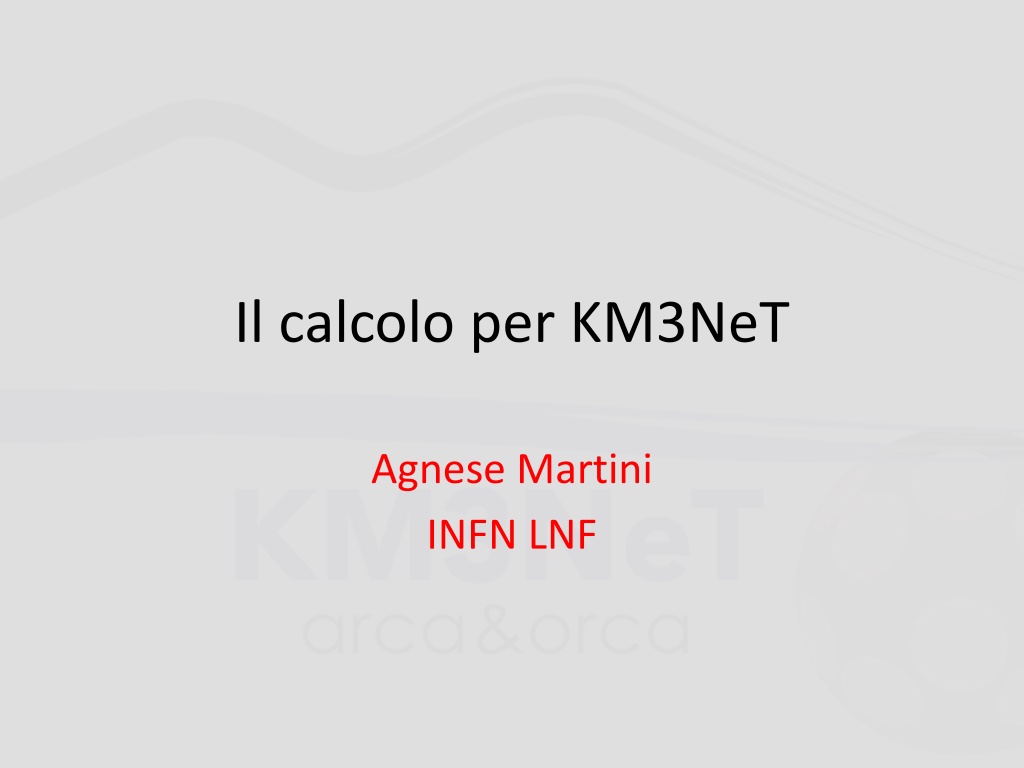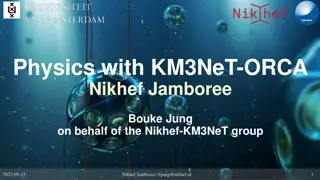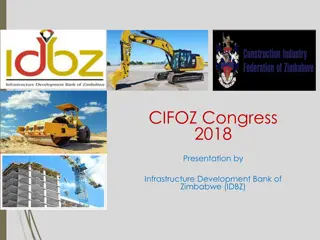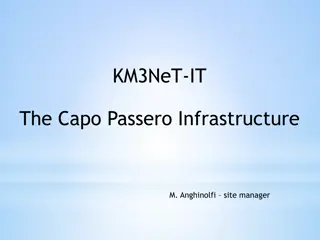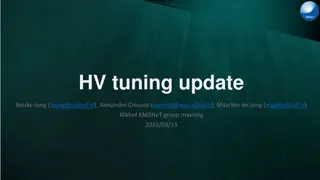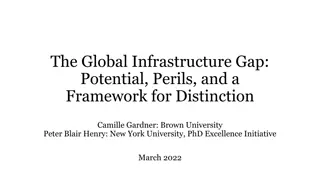The KM3NeT Research Infrastructure
The KM3NeT research infrastructure includes the deep-sea neutrino telescope (ARCA) and the neutrino-mass hierarchy detector ORCA at different sites. The detectors consist of building blocks with optical modules each containing photomultipliers for data transmission. The infrastructure is distributed across France, Italy, and Greece, connected via a deep-sea cable network to shore. The computing model is based on the LHC model with a hierarchical data processing system. Current status includes network issues in the Italian and French seafloor networks, with repair operations ongoing. The setup and deployment progress are detailed in a workshop presentation by Agnese Martini.
Download Presentation

Please find below an Image/Link to download the presentation.
The content on the website is provided AS IS for your information and personal use only. It may not be sold, licensed, or shared on other websites without obtaining consent from the author.If you encounter any issues during the download, it is possible that the publisher has removed the file from their server.
You are allowed to download the files provided on this website for personal or commercial use, subject to the condition that they are used lawfully. All files are the property of their respective owners.
The content on the website is provided AS IS for your information and personal use only. It may not be sold, licensed, or shared on other websites without obtaining consent from the author.
E N D
Presentation Transcript
Il calcolo per KM3NeT Agnese Martini INFN LNF
The KM3NeT infrastructure (I) The KM3NeT research infrastructure will comprise a deep-sea neutrino telescope (ARCA) and the neutrino-mass-hierarchy detector ORCA at different sites and nodes for instrumentation for measurements of earth and sea science (ESS) communities. The cable(s) to shore and the shore infrastructure will be constructed and operated by the KM3NeT collaboration. A. Martini Workshop CCR 22-05-2017
The KM3NeT infrastructure (II) Both the detection units of ARCA/ORCA and the ESS nodes are connected via a deep-sea cable network to shore. Note that KM3NeT will be constructed at multiple sites (France (FR), Italy (IT) and Greece (GR)) as a distributed infrastructure. The set-up shown in Figure will be installed at each of the sites. A. Martini Workshop CCR 22-05-2017
The detector The ARCA/ORCA will consist of building blocks (BB) containing 115 detection units (vertical structures supporting 18 optical modules each). Each optical module holds 31 3-inch photomultipliers together with readout electronics and instrumentation within a glass sphere. One building block thus contains approximately 65,000 photomultipliers. Each installation site will contain an integer number of building blocks. The data transmitted from the detector to the shore station include the PMT signals (time-over-threshold and timing), calibration and monitoring data. Phase Detector Layout No. of DUs Phase 1 approx. BB 2 BB ARCA/ 1 BB ORCA 31 DUs Phase 2 345 DUs Final Phase 6 building blocks 690 DUs Reference 1 building block 115 DUs A. Martini Workshop CCR 22-05-2017
The detector status Status Italian Seafloor Network: down since 16thof April for power failure. After investigations The network will be powered off until a ROV inspection that we are investigating the possibilities Status of the French seafloor Network: A repair operation of the cable that connects the infrastructure is currently ongoing. The fault was located in a joint close to the node and the repair should be completed in the next few weeks. 2 DU are being prepared for deployment in France this summer. DOM/DU integration: The overall integration of DOM s and DU s is not affected by any of the network problems and will be pursued without delay. A. Martini Workshop CCR 22-05-2017
The KM3NeT Computing Model The KM3NeT computing model (data distribution and data processing system) is based on the LHC computing model. The general concept consists of a hierarchical data processing system, commonly referred to as Tier structure A. Martini Workshop CCR 22-05-2017
Data processing steps at the different tiers Tier Computing Facility Processing steps triggering, online- calibration, quasi- online reconstruction Access direct access, direct processing Tier-0 at detector site direct access, batch processing and/or grid access calibration and reconstruction, simulation Tier-1 computing centers local computing clusters simulation and analysis Tier-2 varying A. Martini Workshop CCR 22-05-2017
Computing centres and pools provide resources for the KM3NeT Tier Computing Facility Main Task Access direct access, direct processing direct access, batch processing and grid access Tier-0 at detector site online processing general offline processing and central data storage Tier-1 CC-IN2P3 general offline processing and central data storage general offline processing, interim data storage reconstruction of data CNAF grid access ReCaS grid access HellasGrid grid access direct access, batch processing HOU computing cluster simulation processing local computing clusters Tier-2 simulation and analysis varying A. Martini Workshop CCR 22-05-2017
Detailed Computing Model A. Martini Workshop CCR 22-05-2017
Data distribution The raw data must be transferred from Tier0s (detector sites) to Tier1s: CC-IN2P3 and CNAF. The 2 storages must be mirrored. The data resulting from all the processing tasks have to be transferred to the Tier1s The main task is to implement an efficient data distribution and mirroring system between these 2 centers that implement different data transfer protocol iRODS (Integrated Rule-Oriented Data System ) at CC-IN2P3 GridFTP (File Transfer Protocol for grid computing) at CNAF A. Martini Workshop CCR 22-05-2017
Detector Deployment (DUs at beginning of the year) year 2018 Detector Layout 4 Dus ORCA 2 Dus ARCA 0,3 building block ORCA 0,25 building block ARCA 1building block ORCA 1/2 building block ARCA 1 building block ORCA 1,3 building block ARCA 1 building block ORCA 2 building block ARCA No. of DUs 6 DUs 2019 65DUs 2020 170 DUs 2021 260 DUs 2022 345 DUs 1 Building block = 115 DUs A. Martini Workshop CCR 22-05-2017
Overview on computing requirements at T1s per year per year size (TB) computing time (HS06.h) computing resources (HS06) One Building Block 2018 2019 2020 2021 2022 1000 250 750 500 2000 3000 350 M 25 M 350 M 150 M 700 M 700 M 40 k 3 k 40 k 20 k 80 k 80 k A. Martini Workshop CCR 22-05-2017
Detailed expectations of necessary storage and computing time for one building block (per processing and per year) processing stage size per proc. (TB) time per proc. (HS06.h) Size per period (TB) time per year (HS06.h) periodicity ( year) Raw Data Raw Filtered Data Monitoring and Minimum Bias Data Experimental Data Processing 300 - 300 - 1 150 - 150 - 1 Calibration (incl. Raw Data) 750 24 M 1500 48 M 2 Reconstructed Data DST Simulation Data Processing Air showers atm. Myons neutrinos total: 150 75 119 M 30 M 300 150 238 M 60 M 2 2 100 50 2 827 14 M 1 M 22 k 188 M 50 25 20 995 7 M 638 k 220 k 353 M 0.5 0.5 10 First building block deployed in 2 years A. Martini Workshop CCR 22-05-2017
Networking phase connection average data transfer (MB/s) peak data transfer (MB/s) Building Block: Tier-0 to Tier-1 Tier-1 to Tier-1 Tier-1 to Tier-2 25 50 10 125 500 50 Final Phase: Tier-0 to Tier-1 Tier-1 to Tier-1 Tier-1 to Tier-2 200 500 100 1000 5000 500 Rough estimate of the required bandwidth. Note that the connection from Tier-1 to Tier-2 has the largest fluctuation, driven by the analyses of data (i.e. by users) A. Martini Workshop CCR 22-05-2017
KM3NeT on the GRID VO Central Services Service Authentication/authorization system VOMS User Interface Logical File Catalog Job submission and management system (WMS) Site RECAS-NAPOLI RECAS-NAPOLI, HellasGrid-Okeanos, CNAF, Frascati RECAS-NAPOLI HellasGrid-Afroditi KM3NeT is starting on the GRID use case: CORSIKA simulation A. Martini Workshop CCR 22-05-2017
GRID sites supporting the VO KM3NeT CPU (not pledged) Site name Storage (TB) 440 120 654 2016 25504 1500 64 HG-03-AUTH HG-08-Okeanos INFN-BARI INFN-FRASCATI INFN-T1 - 200 320 RECAS-NAPOLI UNINA-EGEE A. Martini Workshop CCR 22-05-2017
HS06.h the last year HS06.h at Tier1 CNAF HS06.h at Tier2s Italy A. Martini Workshop CCR 22-05-2017
INFN for OBELICS 3.4 Activities in WP 3.4 (1/3) CORELib: COsmic Ray Event Library Background to many experiments Also a tuning benchmark Potentially useful to other communities Currently using CORSIKA as generator Status of production Proton-induced showers: o HEMODELS: QGSJET01 with CHARM, QGSJET01 with TAULEP, QGSJET-II with TAULEP, EPOSLHC with TAULEP o LEMODEL: GHEISHA o about 21M Evts per HEMODEL o 7 energy bins (2 102GeV-103GeV+equally logarithmically spaced from 1TeV to 109GeV) o power-law spectrum with -2 spectral index o zenith angle from 0 to 89 degrees Nuclei-induced showers: o HEMODELS: QGSJET01 with CHARM, QGSJET01 with TAULEP, QGSJET-II with TAULEP, EPOS-LHC with TAULEP o LEMODEL: GHEISHA o about 21M Evts per HEMODEL o 7 energy bins (A 2 102GeV-A 103GeV+equally logarithmically spaced from A 1TeV to A 109GeV) o power-law spectrum with -2 spectral index o zenith angle from 0 to 89 degrees A. Martini Workshop CCR 22-05-2017
INFN for OBELICS 3.4 Activities in WP 3.4 (1/3) CORELib: COsmic Ray Event Library Status of production Energy range (GeV) 200-1000 103-104 104-105 105-106 106-107 107-108 108-109 Number of events 107 107 106 105 104 103 102 QGSJET01 Production done with and without Cherenkov radiation High energy model Low energy model Option TAULEP CHARM GHEISHA X QGSJET01 GHEISHA X QGSJETII- 04 GHEISHA X EPOS LHC GHEISHA X A. Martini Workshop CCR 22-05-2017
INFN for OBELICS 3.4 Activities in WP 3.4 (2/3) ROAst: ROot extension for Astronomy Classes to access astronomical catalogues Coordinate transformation Moon position and motion Generators of primary particles (neutrinos will be implemented, others will be supported only as placeholders) Status Catalogue name Status UCAC4 Supported LUNAR MOTION: DONE URAT1 Supported GSC-II (Guide Star Catalog) Supported Fermi-LAT 3FGL Supported TeVCat Supported Astronomical coordinate system Geographical coordinate system Time coordinate Equatorial N/A N/A Galactic N/A N/A Horizontal Lat-Long/UTM Unix time/UTC/Local Sidereal Eclyptic rectangular N/A N/A A. Martini Workshop CCR 22-05-2017
Summary The data distribution model of KM3NeT is based on the LHC computing model. The estimates of the required bandwidths and computing power are well within current standards. A high bandwidth Ethernet link to the shore station is necessary for data archival and remote operation of the infrastructure. KM3NeT-INFN already addressed requests to CCR KM3NET is already operative on GRID We are also active on Big Data future challenges, i.e. Asterics A. Martini Workshop CCR 22-05-2017
